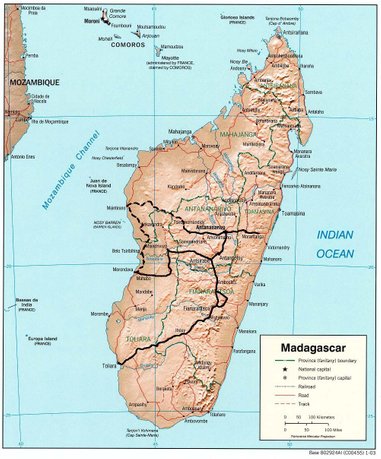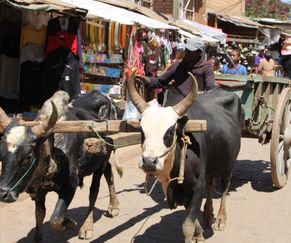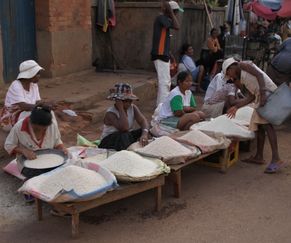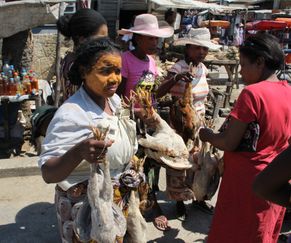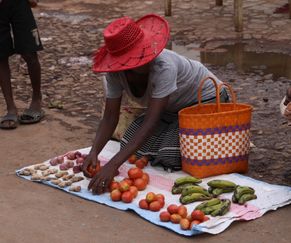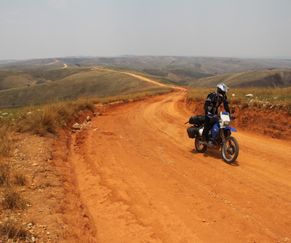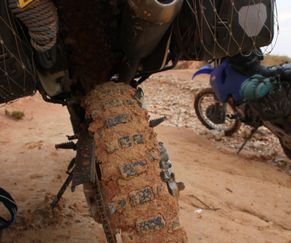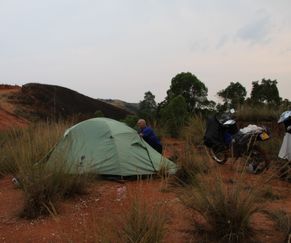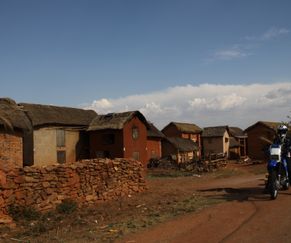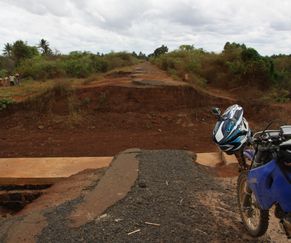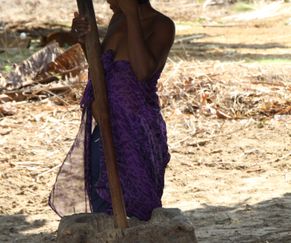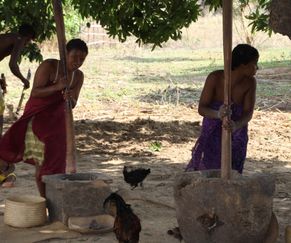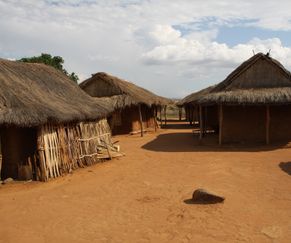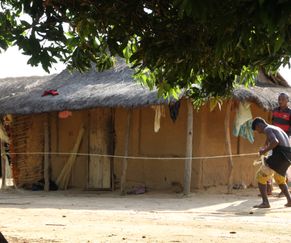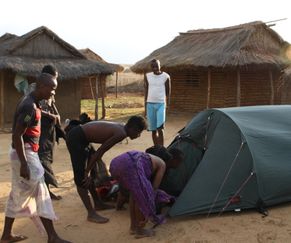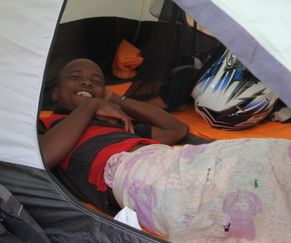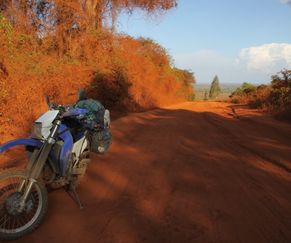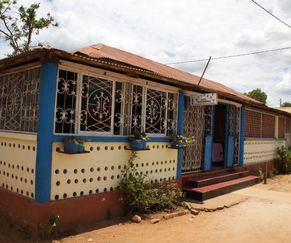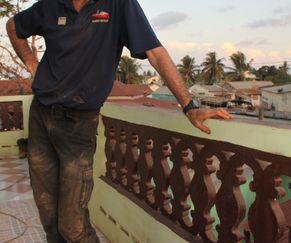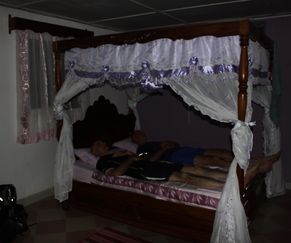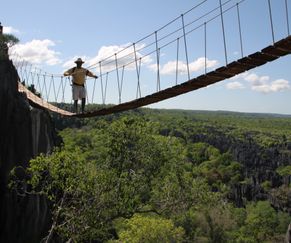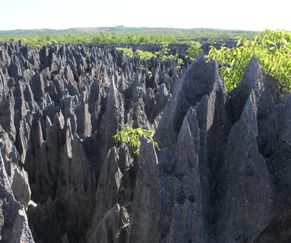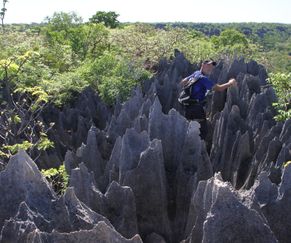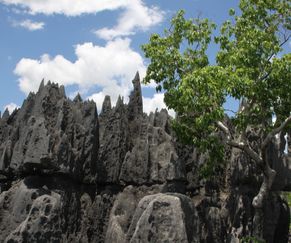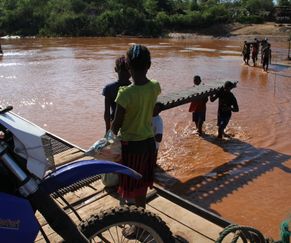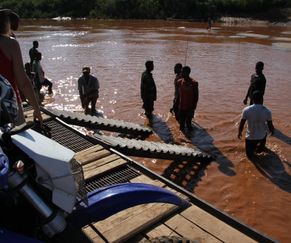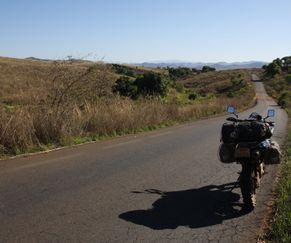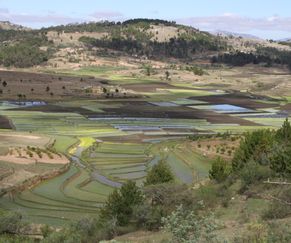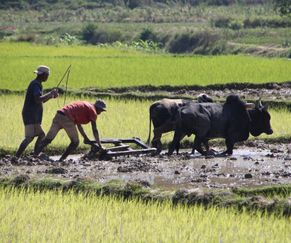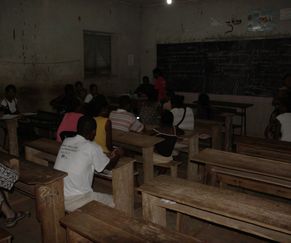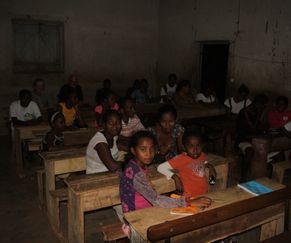Madagascar.
Our plan was simple. We fly our Suzukis beforehand to Madagascar. Then we fly when the bikes arrived, pick them up and ride. At least, this was the plan...
Now we wait already 12 days for our bikes, due to strikes at Air France in Paris and due to customs issues for temporary import. In the mean time we use the time to explore Anta and their beautiful people. We stroll over markets and watch the colorful people. But then finally a bus from the freight forwarder arrives at our hotel with our box with the bikes. In the dark we unload the bikes and build them together.
The start.
The next morning we find our way out of the busy traffic of Antananarivo (Anta), the capital of Madagascar. After one hour of stop and go traffic we are out of the city. We see women doing their laundry in the river and spread the clothes on the ground to dry. Clay from the river is formed into bricks, stacked in a square block where under a fire is made. This way the bricks are baked.
National road no. 1 is paved till Tsiroahomandidy (what's in a name...), but then it becomes a red laterite piste. The road winds up into green hills, it's hot and our sweat is running from under our helmets. We stop to drink some water. When we ride on it starts to rain. After a few kilometers the laterite becomes very slippery and we slide over the road. The laterite clay sticks to our tires and makes them twice the size. With our feet over the ground we move slowly forward. But when the road goes up a hill we loose all grip and cannot get up. What now? The rain gets heavier and we decide to shelter under our ground sheet of our tent that we place over our bikes. First we make a cup of coffee and wait. When the rain stops and the sun breaks through, the clay road is still very slippery. We push our bikes up the hill. There is a nice flat area where we can pitch our tent.
Endangered species.
The next morning the sun colors an orange glow over the misty rain forest. This is peaceful. With a cup of coffee in my hand I walk to the road, where a truck is trying to drive up the hill. He cannot make it. All the passengers has to get out and he tries again. Yes, he did it, but now he is sliding down, Mmm, the road is still slippery. After breakfast we pack all our stuff and go on. First it is still slippery but the sun has already power enough to dry the road.
In a little village we stop for the lunch. On the ground on a sheet a woman sells bananas. This is the most simple form of a shop. We buy some bananas and in a restaurant we can get a cola. Warm, because they have no refrigerator, nor electricity. Cooking is done on a charcoal fire. The people here don't see often foreign travelers, so everybody is coming to see us. And of course we look interested to them. Many kids walk in worn out clothes and barefoot or on old slippers. Men and women often wear a hat against the sun. And women smear a yellow cream, made of tree bark, on their face as a sun cream. It looks a bit funny. But how poor the people here are, they smile and they like it if we make pictures of them and show them on our camera display.
We notice that the landscape is quite barren, there are almost no trees. We see many tree stumps, some bushes in the arid grassland. Now we know why, because everybody in Madagascar is cooking on charcoal fire and they chop the forest for firewood. In the meantime this is a huge problem. There is soil erosion and the natural habitat for the animals is rapidly declining. Some species are already endangered with extinction.
Beautiful people.
Suddenly the DRZ of Udo starts to sputter. I think it is lacking of petrol. We check the petrol hose to the carburator and filter, but everything seems OK. The bikes starts again and we go on. It hold in, revs up, dies. We are in the middle of the nowhere and we don't like the idea of repairing the bike here. So with a sputtering engine Udo continuous. But it's no fun. Every few minutes the bikes dies. It starts easy, ride a few minutes and again... In the late afternoon we see a few huts and we stop. A familiy is sitting in the shade of a huge mango tree. Two women are thrashing rice, a man is cutting fire wood and another man is weaving a rope. There is a pig tight with a rope to a fence and a few chickens are running around. We ask if we can pitch our tent here for the night, but they don't speak english nor french. Harald is drawing a tent in the sand and makes a sleeping gesture. They got it. We unpack our tent and put it up. They never saw this and are very interested. We spread our self-inflating mattrass and our sleeping bag. We invite them to take place in the tent and one by one they try it. They giggle a lot and have fun. We boil some water for an instand soup on our petrol stove and again they are amazed. They cook on char coal. We let them try our curry soup, but they don't like it. They spit it out and we all laugh.
The next morning they bring us 2 eggs. We boil them for breakfast and when we leave we want to thank these beautiful people a lot for their hospitality. We give them some money, a lighter and our 15 meter long rope. The men are so happy with that and immediately they share it in 2 equal pieces.
Udo's DRZ is still sputtering and finally we reach on very dusty tracks Maintirano on the west coast. We are looking for a hotel and find Hotel Rovasoa, that has a large courtyard, where we can park the bikes. We drink first a cold cola and then we explore the city. Old carts, often fully loaded with goods, are pulled by zebus. At the market it is busy. Stalls with tomatoes, bananas, rice, but also clothes, electronics and bicycle parts.
River crossing.
Today is bike-repair day. We check again the fuel lines, carburator and sparkplug, but everything is OK. We measure a bit low 13 V at the battery. Mmmm... The good thing is that we have the same bikes, so we can exchange parts. We exchange the battery, the regulator, cdi unit and every time Udo makes a test ride. Nope, no improvements. So we have one more option. We take out the dynamo and place a new spare one. Test ride, and.... Yes, everything seems to work how it should be. No sputtering and dying of the engine. The cook of the hotel sits a few meters away and watched us all day. Now she is cleaning a fish and point to us. That will be our diner tonight. It becomes a feast meal with potatoes, tomato, onion and a cold Tree Horses beer. Cheers!
Long flat red laterite pistes make place for hilly tracks with boulders. Slowly we trail up. At a few huts we stop. They are braid together from branches and reed and have a roof of reed. Women stop with rice pounding and kids are looking wonderingly to us. We buy some bananas to get our energy level back. When we are back on the track we reach a 50 meter wide river. There is no bridge nor a ferry. Harald takes off his shoes, put on his Teva's and walks into the river to see how deep it is and if there are no big rocks. Water comes just above his knee and there are no rocks, he says. Just some muddy soft bottom. Carefully Udo ride into the river and opens the throttle. A huge water bow is formed and the mud has some resistance. But keeping the throttle wide open, Udo reach the other side. Completely soaked, that is... Harald makes it also without problems.
Tsingy de Bemaraha reserve.
At 5 o'clock in the morning the alarm goes off and after a quick breakfast we go with 2 American travelers in their rented SUV with driver and guide to Tsingy de Bemaraha Reserve. At the starting point for the day walk, we get a briefing from the guide Hubert and he helps us to put on climbing belts. Then we are off. We walk through a tropical forest and soon we start to climb over a rocky trail. Some parts are steep and we have to secure us to steel cables on the rocks. Hubert warns again for the razor sharp edges of the rocks. It is quite tough. This limestone plateau are actually deposits of fossils and dead shells on the sea bottom. By the break up of the super continent Gwondana Madagascar was born. Madagascar lies partly on the edge of the rift that is pushed up. This is how Tsingy is arised. By wind and water the limestone eroded into bizarer, sharp ridges. Heavily sweating and breathing we arrive at the top of the plateau, The view is superb. Bizarre black-grey rock formations stand out above the green tropical forest. We climb between the ridges. Then we have to pass over a valley via a suspension bridge. The bridge is at least 30 meter high. We have to secure our selves with a carabiner and step on the suspension bridge. The bridge shakes with every step and I can look through the wooden shelfs into the depths. This is quite exciting. Hubert waits till everybody is over the bridge and then we move on. After the descent Hubert has another surprise for us. We have to go through a 300 meter long cave. Some parts the way through is so narrow that we have to take off our bagpacks. As a team we give the bagpacks and cameras to the one who is on front of you, so that you have boths hands free to squeeze yourself through the small splits. This is funny to do.
Back to school.
At Bekopaka we come across a wide river. Again! But luckily there is a ferry. The boys of the ferry put a metal ramp plate between the ferry and the sandy shore. It's only 40 cm wide. Udo rides to the plate, opens his throttle and jumps on the ferry. Harald follows, but his engine dies and he looses his balance and falls in the river. His Suzuki still hangs on the ramp plate. Together with the boys we pick up the bike and pushes it on the ferry. A 4WD car joins us and one boy starts an old diesel engine and the ferry moves. But halfway the river the ferry stops. What now? It stopped on a sandbank. Then we see boys from the other shore walking into the river. They carry ramp plates and put them on the ferry. The 4Wd goes first. We have to go off next. The plates are steep, the boys standing up to their knees in muddy water and smile. OK. We ride off the plates without problems and keep speed in the river. Water splashes over the tank into our faces. Soaked again! The guys from the ferry are smiling and raising their hands.
Because we lost 2 weeks at the customs we have to adjust our itinerary plans. We decide to go from Morondava on the west coast by the paved route to the inland. The road meanders into the Central High plains at an altitude between 1000-1500 meters. Everywhere we see rice paddies and rice terraces. One more green than the other. Women standing bowed in water to plant rice and boys are walking behind a zebu with plow in the mud. At the end of the day we stop in a little village to look for a hotel and Dennis greet us in english. He teaches English language at a school and shows us a hotel. It is very basic, it is a cheap hotel for locals, not for tourists. But OK for us. Dennis is interested in our story and invites us for a class tonight. That looks nice and after a diner we go with him to school. When we arrive some students are already waiting and Dennis opens the door. It is an old dark building and in the classroom are only wooden benches, a desk for the teacher and a big blackboard on the wall. They windows are opened for a little cooling. We take place in the back (like in our own schooldays, haha). Dennis checks the present list and the students come forward and pay their lesson. Lesson today: the "past simple". He writes a sentence on the blackboard and the students have to say it loud. And again. It is nice to see how he give class and is a very passionate teacher, even that he is only 25 years old. He thinks that it is important for his students that they learn english, because it is spoken all over the world. Yep, we agree. Then the students can ask us questions. Questions like where are we from?, how is school in the Netherlands?, If we like Madagascar and the people? When we answer the questions and tell a bit about our trip, they listen attentive. After class they all shake our hands and thank us. Well, we thank you, it was a pleasure to be in your class.
Avenue of Baobabs.
The more south we go, the more arid the landscape becomes. A chameleon crosses the road, luckily we did not ran over him. Also we see the first baobab trees. With their long bald branches that look like roots, it seems that they are standing up side down. From the eight species, six are present in Madagascar. At the avenue of baobabs near Morondova they are standing along the road. It is amazing to ride bewteen these giants.
In Ranomafana National Park we do a day trekking through the rainforest. Our guide goes in front and quickly she spots a Bamboo lemur in a tree. This little brown lemur is sitting on a branch and is not bothered by us. Lemurs or makis are primitive primate species and live only in Madagascar. In Ranomafana there are 12 species and some are endangered by deforestation, which is a huge problem in Madagascar. We see a Golden lemur and jumping Sifakas. Suddenly we hear a loud cry and our guide say that we have to hurry. We ran after her and after 10 minutes she stops and we see a group of Indris. These are the largest lemurs and have a thick black-white fur. One of them is starring at us and then he makes an enormous cry. He climbes higher in the tree and jumps to another tree. This is fantastic!
Dramatic rocks arise above the arid grassland when we ride towards Toliara. Everytime we are surprised about the changing landscape. In Toliara we take room in hotel Manatane, that is direct located on the beach. It is very cosy with native art and our room has a balcony with view to the sea. We take a few days to relax and eat the best pizza in Le Blu restaurant that we had on the Southern hemisphere. On our last night we sit with a bottle of wine on the beach and watch the sun setting. The sky colors orange, warm wind blows in our face, a local walks on the deserted beach and our thoughts are going to the amazing routes we traveled and the great people we met. It was magnificent. Thank you Madagascar.
© copyright BikeBrothers
